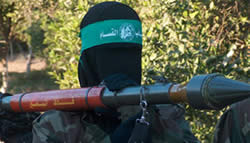As Israeli troops push deeper into the Gaza Strip, the international community is crying out for humanitarian aid to civilians not engaged in the fighting. The problem is that these funds rarely reach the intended recipients. The following is a partial list of how Hamas has spent its much of its donor funds since Israel’s unilateral disengagement from Gaza in 2005:
- Qassam Rockets: The most common rocket launched out of Gaza is the Qassam. Made of a simple steel casing and a number of easy-to-find household items, these projectiles have wreaked havoc in Southern Israel, forcing civilians to scramble for cover. On one December day alone, Hamas fired 60 Qassams into Israeli territory. At roughly $200 a piece, these rockets can be built with virtually no limitations.
- Tunnels: Underground tunnels connecting Gaza to Egypt’s Sinai Peninsula are the lifeline of both the Hamas economy. They also ensure that Hamas maintains its military capabilities. Published reports estimate that there were close to 1,000 operational tunnels before Israel destroyed untold numbers of them as part of Operation Cast lead. The cost of construction of a “standard” 1500 square foot passageway ranges between $60,000 and $90,000. Larger tunnels with more elaborate designs can run as high as $150,000 to complete. Once built, Hamas also profits by taxing the owners of the tunnels.
- Salaries of Fighters: An October 2007 Reuters report revealed that Hamas pays the salaries of 10,000 security officials and 10,000 civil servants in cash. By paying them in cash, the idea of accountability to the international community is eliminated. It also reduces the waiting for Hamas fighters. “I received my salary from a suitcase, we did not have to stand in line at banks,” said one Hamas fighter. Published reports put the monthly payroll of the organization at roughly $9 million.
- Financial support for family members of terrorists: Through a network of charities, the family members of “martyrs”- suicide bombers, rocket launchers and snipers- all receive support from Hamas. The Israeli government believes that each family gets a one-time gift of between $500 and $5,000. After that, they get monthly stipends of $100. In total, these checks can add up to about $30 million annually.
- More Advanced Rockets: While the primitive, first generation Qassams are more than adequate to terrorize Israeli towns in the area known as the Gaza Belt, more sophisticated rockets, capable of reaching farther into Israel and able to cause more serious damage, are on the way. From a strategic standpoint, the repeated pounding of Sderot -with a population of just about 24,000 and limited industry- might be described by military analysts as more of a nuisance than an existential threat. Recent attacks using more sophisticated rockets on the port city of Ashkelon have raised the stakes. With a population of over 100,000, a petroleum pipeline and other important infrastructure projects, the rockets raining on Ashkelon now pose a more serious threat. According to one rocketeer interviewed in the Christian Science Monitor, the cost of the new rockets capable of hitting Ashkelon rocket was $900. How many such rockets no w exist is unknown.
- Media
As it has done with its military tactics, Hamas has fashioned its public relations and media machine after those of Hezbollah. Like Hezbollah’s Al-Manar television network, the Al-Aqsa network of Hamas doles out a regular diet of anti-Israel and anti-Semitic material. Western media has reported on Farfel, a character similar to Mickey Mouse, who urges Palestinan children to kill Israelis. In another video (aired recently on MSNBC), a Hamas puppet show features a young boy stabbing the American President to death, while declaring that the White House will soon be turned into a mosque. As grotesque as these scenes are, they are not what make Al- Aqsa so dangerous, according to Mark Dubowitz, Executive Director of the Foundation for Defense of Democracies and co-director of the FDD-led Coalition Against Terrorist Media. “Al -Aqsa is more than a television station,” Mr. Dubowitz says. “It is an operational weapon supporting the terrorist20activity of Hamas. It is involved in recruitment of terrorists, fundraising and even pre-attack surveillance.” Mr. Dubowitz and his organization were responsible for convincing nine international satellite companies to stop carrying Al-Manar, and worked with the US government to designate Al-Manar as a terrorist entity. They are working on a similar strategy against Al-Aqsa. While Al- Manar has an annual budget of close to $20 million, Al-Aqsa is thought to be operating with considerably less funds.
So while aid is desperately needed for the people of Gaza, money rarely gets to those who need it most. Furthermore, between misappropriated humanitarian funds and the money sent with the specific purpose of funding jihad, such unregulated cash has certainly done more harm than good for those Palestinians eager to live a better life.
Robert Ivker is a missile defense analyst for Palestinian Rocket Report. He is a former journalist at the United Nations and author of One Town’s Terror: 9/11, Iraq and Burlington, Vermont (2006).











Its a real shame that more people don’t know about this. In my country (Ireland) many people live under the illusion that Palestinians are persecuted, downtrodden people who had their land, nationality and lifeblood stolen by Israelis who have no connection to the Holy Land. If only the Israeli propaganda machine were half as effective as that of Hamas et al. Good to see that this time round some of the other side of the story is coming out.